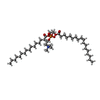+Search query
-Structure paper
| Title | Structural basis for double-stranded RNA recognition by SID1. |
|---|---|
| Journal, issue, pages | Nucleic Acids Res, Vol. 52, Issue 11, Page 6718-6727, Year 2024 |
| Publish date | Jun 24, 2024 |
 Authors Authors | Runhao Wang / Ye Cong / Dandan Qian / Chuangye Yan / Deshun Gong /  |
| PubMed Abstract | The nucleic acid transport properties of the systemic RNAi-defective (SID) 1 family make them attractive targets for developing RNA-based therapeutics and drugs. However, the molecular basis for ...The nucleic acid transport properties of the systemic RNAi-defective (SID) 1 family make them attractive targets for developing RNA-based therapeutics and drugs. However, the molecular basis for double-stranded (ds) RNA recognition by SID1 family remains elusive. Here, we report the cryo-EM structures of Caenorhabditis elegans (c) SID1 alone and in complex with dsRNA, both at a resolution of 2.2 Å. The dimeric cSID1 interacts with two dsRNA molecules simultaneously. The dsRNA is located at the interface between β-strand rich domain (BRD)1 and BRD2 and nearly parallel to the membrane plane. In addition to extensive ionic interactions between basic residues and phosphate backbone, several hydrogen bonds are formed between 2'-hydroxyl group of dsRNA and the contact residues. Additionally, the electrostatic potential surface shows three basic regions are fitted perfectly into three major grooves of dsRNA. These structural characteristics enable cSID1 to bind dsRNA in a sequence-independent manner and to distinguish between DNA and RNA. The cSID1 exhibits no conformational changes upon binding dsRNA, with the exception of a few binding surfaces. Structural mapping of dozens of loss-of-function mutations allows potential interpretation of their diverse functional mechanisms. Our study marks an important step toward mechanistic understanding of the SID1 family-mediated dsRNA uptake. |
 External links External links |  Nucleic Acids Res / Nucleic Acids Res /  PubMed:38742627 / PubMed:38742627 /  PubMed Central PubMed Central |
| Methods | EM (single particle) |
| Resolution | 2.21 Å |
| Structure data | EMDB-38227, PDB-8xbs: EMDB-38236, PDB-8xc1: |
| Chemicals |  ChemComp-ZN:  ChemComp-CLR:  ChemComp-POV:  ChemComp-NAG: |
| Source |
|
 Keywords Keywords | MEMBRANE PROTEIN / dsRNA recognition |
 Movie
Movie Controller
Controller Structure viewers
Structure viewers About Yorodumi Papers
About Yorodumi Papers









